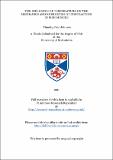The influence of temperature on the mechanics and energetics of contraction in fish muscle
Abstract
Chapter 1. A general introduction into the adaptation of teleost fish to changing thermal environments. The underlying mechanisms at all levels of organization are reviewed in relation to adaptive change over evolutionary and seasonal time-scales. Chapter 2. 1. The contractile properties of swimming muscles have been investigated in marine teleosts from Antarctic (Trematomus lepidorhinus, Pseudochaenichthys georgianus), temperate (Pollachius virens. Limanda limanda. Agonis cataphractus. Callionymus lyra) and tropical (Abudefduf abdominalis, Thalassoma duperrevi) latitudes. 2. Small bundles of fast twitch fibres were isolated from anterior myotomes and/or the pectoral fin adductor profundis muscle (m.add.p). Live fibre preparations were viable for several days at in vivo temperatures, but became progressively inexcitable at higher or lower temperatures. The stimulation frequency required to produce fused isometric tetani increased from 50Hz in Antarctic species at 0°C to around 400 Hz in tropical species at 25°C. Maximum isometric tension (P0) was produced at the normal body temperature (NBT) of each species (Antarctic, 0-2°C; North Sea and Atlantic, 8-10°C; Indo-West Pacific, 23-25°C). P0 values at physiological temperatures (200-300 kN m-2) were similar for Antarctic, temperate and tropical species. 3. A temperature induced "tension hysteresis" was observed in muscle fibres from the temperate and Antarctic species. Chapter 3. 1. Fast and slow muscle fibres were isolated from the myotomes of atlantic cod (Gadus morhua L.) and short-horned sculpin (Myoxocephalus scorpius L.). 2. Epinephrine was found to have no effect on twitch or sub-tetanic contractions in fast muscle fibres. 3. Isoprenaline (10-6M) had no effect on the contractility of slow muscle fibres. 4. In contrast, epinephrine elicited a dose-dependent decrease in the half-time for twitch relaxation (t1/2r), and in most cases a decrease in twitch amplitude. Chapter 4. 1. Fast muscle fibres were isolated from the abdominal myotomes of the short-horned sculpin, Myoxocephalus scorpius L. Sinusoidal length changes were imposed about resting muscle length and fibres stimulated at a selected phase during the strain cycle. The work output per cycle was calculated from the area of the resulting force- position loops. Chapter 5. 1. Bundles of 20-30 fast muscle fibres were isolated from the abdominal myotomes of the short-horned sculpin (Myoxocephalus scorpius L.). 2. The energy cost of contraction was measured during oscillatory work at 4°C and 15°C following treatment with iodoacetate and nitrogen gas to block glycolysis and aerobic metabolism. 3. Isolated fibres were subjected to sinusoidal length changes about in situ resting length and stimulated at a selected phase in the strain cycle. Preliminary experiments with untreated preparations established the strain amplitude and stimulation parameters required to maximize work output over a range of cycle frequencies at 4°C and 15°C. Chapter 6. The results of the thesis are discussed, particularly in relation to their evolutionary and locomotory significance. From the principles and ideas formulated, future lines of research are suggested. (Abstract shortened by ProQuest.)
Type
Thesis, PhD Doctor of Philosophy
Collections
Items in the St Andrews Research Repository are protected by copyright, with all rights reserved, unless otherwise indicated.

